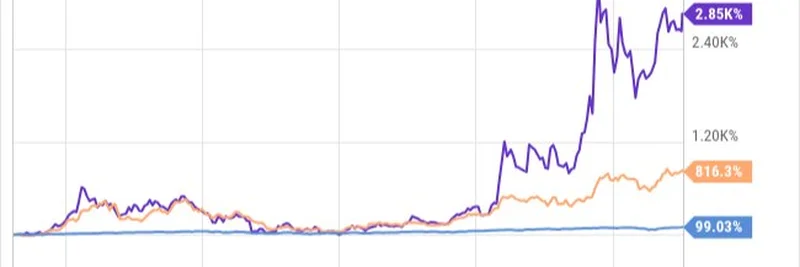Hey there, crypto enthusiasts! If you’ve been keeping an eye on the Bitcoin scene, you’ve probably noticed some exciting shifts in 2025. Lyn Alden, a well-known voice in the investment world, recently dropped a fascinating thread on X that dives into the rise of Bitcoin treasury companies and the ongoing debate about Bitcoin’s role as a store of value versus a medium of exchange. Let’s break it down in a way that’s easy to digest, even if you’re new to the blockchain game.
What’s the Buzz About Bitcoin Treasury Companies?
So, what’s a Bitcoin treasury company? Imagine a corporation—like MicroStrategy (MSTR)—that decides to stash Bitcoin on its balance sheet instead of just holding cash. This trend kicked off around 2020, but 2024 and 2025 have seen a massive wave of adoption, thanks to changes in how Bitcoin is accounted for and a growing belief in its long-term value. The chart Lyn shared shows just how wild this ride has been: MSTR’s total return has skyrocketed by 2.85%, while Bitcoin itself is up 816.3% since 2021, outpacing the S&P 500’s modest 99.03%.
Why are companies jumping on this bandwagon? It’s all about leveraging Bitcoin’s potential. For one, it gives corporations a way to protect their cash from inflation—a sneaky thief that erodes purchasing power over time. Plus, with the right strategy, they can use leverage (borrowing money) to amplify their Bitcoin holdings, betting big on its future growth. Unlike hedge funds that might face margin calls during dips, corporations can issue bonds with longer terms, giving them more flexibility to ride out volatility.
Why Investors Care
But it’s not just companies getting in on the action—investors are loving it too! If you’re managing a fund with strict rules (say, only buying stocks), you can’t just toss Bitcoin into the mix. Enter Bitcoin treasury companies. They let fund managers get exposure to Bitcoin through stocks or bonds, fitting neatly into their investment mandates. Lyn even shared a personal story about adding MSTR to her portfolio back in 2020 when direct Bitcoin access was tricky—proof that this strategy works for real-world investors.
The leverage angle is another win. Corporations can use long-term debt to boost returns, avoiding the pitfalls of daily-reset leveraged ETFs that often lose value over time. It’s like choosing a sturdy ship over a leaky boat for a long voyage!
Store of Value vs. Medium of Exchange: The Big Debate
Now, let’s talk about the heart of Lyn’s thread: Is Bitcoin a store of value or a medium of exchange? This is where things get juicy. A store of value is something you hold onto because it’s likely to keep or grow its worth—like gold or real estate. A medium of exchange, on the other hand, is what you use every day to buy stuff, like dollars or yen.
Lyn argues that Bitcoin is currently shining as a store of value, especially for corporations and savvy investors. Its fixed supply (only 21 million coins ever) and growing acceptance make it a solid bet for long-term holding. But as a medium of exchange? Not quite yet. The volatility—think 50% drops or 100% jumps in a year—makes it tough for everyday use. Imagine paying rent with Bitcoin only to see its value tank the next day! That’s why stablecoins (crypto tied to stable assets like the US dollar) are stealing the spotlight for quick transactions.
The Path to Success
So, how does Bitcoin go from niche asset to everyday money? Lyn outlines a cool roadmap. It started as a collectible for tech enthusiasts, then became a lifeline for people dodging capital controls (like sending money out of Argentina). Now, it’s evolving into portable capital that corporations and even governments are eyeing. The next steps? Wider adoption could lower volatility, making it a go-to for both holding and spending. But that’s a long game—think decades, not years.
Good or Bad for Bitcoin?
Some folks worry that big corporations holding Bitcoin could centralize it, going against its decentralized roots. Lyn pushes back, saying the network’s design—proof-of-work, distributed nodes—is tough to crack, even with big players involved. Plus, corporate adoption could normalize Bitcoin, making it less of a target for regulators. It’s like adding more players to a game—it makes it stronger, not weaker!
What This Means for You
If you’re into memes or Meme tokens (hey, you’re on meme-insider.com!), this shift might inspire some crossover ideas. Could a Meme token treasury strategy be next? For now, Bitcoin’s corporate journey offers lessons in resilience and innovation. Whether you’re hodling Bitcoin or exploring the wild world of Meme coins, staying informed is key. Check out Lyn’s full article here for a deeper dive, and let’s keep the conversation going in the comments!


